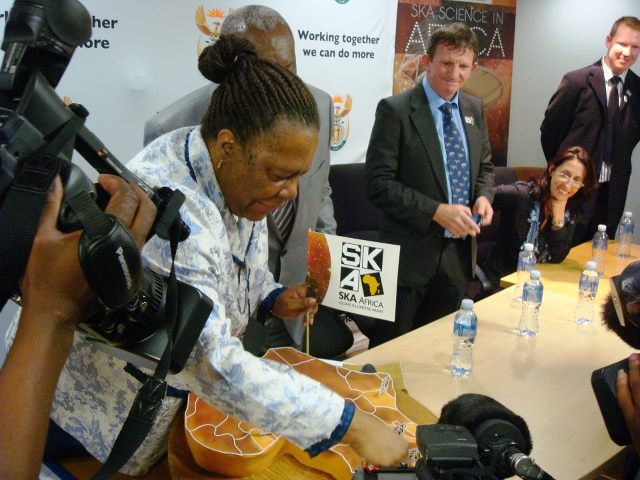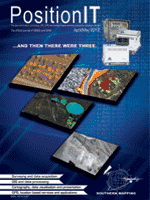 |
|
SA gets lion's share of the SKA, but what's the future of fracking in the Karoo?
by Hans van de Groenendaal, features editor, EngineerIT
Audio of speeches by Minister Naledi Pandor and Prof. Justin Jonas
After nine-years of sweat and tears by the South African and Australian SKA site bid teams, the independent SKA Site Advisory Committee (SSAC), composed of world-renowned experts, carried out an objective technical and scientific assessment of the sites in South Africa and Australia, and by consensus identified Africa as the preferred site.
 | | Minister Naledi Pandor cutting the African SKA cake |
But their recommendation was overturned by the SKA Organisation after complaints by the Australians. "We had hoped the unambiguous recommendation of the SSAC would be accepted as the most sound scientific outcome", said minister of Science and Technology, Naledi Pandor, at a media briefing on Friday 26 May 2012.
It appears the SKA Organisation had difficulty coming to a final decision, and according to one of the members of the committee, the atmosphere at the meeting was heated, and at times the group had to take a recess. The ultimate outcome was that for the sake of inclusivity they agreed to consider constructing one of the three SKA receiver components in Australia, with the other two in Africa.
South Africa, with its eight partner countries - Botswana, Ghana, Kenya, Madagascar, Mauritius, Mozambique, Namibia and Zambia - have been working on the bid to host the SKA since 2003. The final proposal was submitted to the SKA Siting Group on 15 September 2011.
The minister said that an important aspect of the site decision is the recognition of the MeerKAT telescope, being designed and built in the Northern Cape Karoo by South African scientists and engineers, as a critical step towards the implementation of the SKA. The MeerKAT will supplement the sensitive SKA Phase 1 dish array, providing the majority of the collection area of what will be the most sensitive radio telescope in the world.
"This recognition is substantive evidence of the great strides made by the local radio astronomy community since South Africa signaled its interest in the SKA some ten years".
But what of the ambitions of major multi-national oil and energy companies, including Shell and Sasol, to establish a massive shale-gas hydraulic fracturing industry in the Karoo and develop the economy of a pristine and underdeveloped region of South Africa to feed the growing energy needs of the county?
Questions still remain as to whether the SKA project and fracking in the Karoo are indeed mutually exclusive, and whether the decision in May 2011 by minster of energy to place a temporary moratorium on shale gas exploration in the Karoo was merely to safeguard the South African bid for hosting the SKA. Would continued shale-gas exploration and fracking in the Karoo have derailed the SSAC decision that Africa is the preferred site for the SKA?
In a lead editorial in the April 2011 edition of EngineerIT magazine, Dr. Adrian Tiplady, RFI and site characterisation manager, SKA South Africa, wrote: "The introduction of new mining and exploration activity by Shell would not be able to comply with the protection requirements of radio astronomy without very careful and detailed analysis. And even after this analysis, the chances don't look good for compliance. My advice? Just stay away from the SKA."
Further arguments on whether fracking and the SKA are able to co-exist or are mutually exclusive, are given in an article by Ivo Vegter, Brainstorm magazine, June 2011, and the pros and cons of fracking are also given in an article by Mark Botha and Chris Yelland, Energize magazine, June 2011 following an open public debate on the subject hosted by EE Publishers and the Johannesburg Press Club on 24 May 2011.
Is it a coincidence that the report from the task group set up after the moratorium to make recommendations by February 2012 to government about whether fracking be allowed to continue has not been forthcoming even despite a recent meeting of the group of experts to discus the draft? The question that arises now that the fate of the SKA has been sealed is: will the report be released, and will it support continued shale-gas exploration and fracking in the Karoo?
At the media briefing on 25 May 2012, answering a direct question from EngineerIT, Minister Naledi Pandor said that she is not aware of any decision by the minister of Mineral Affairs, or of any license having been issued. "We need to understand the science before any license is given, but I will use the Astronomy Advantage Act (AGA) if need be".
Last year, Dr. Adrian Tiplady said: "Thankfully, back in the real world, the AGA Act exists, and the declaration of Astronomy Advantage Areas is continuing with the support of a large number of stakeholders to ensure that the SKA, and other existing radio astronomy facilities such as MeerKAT, are protected from these kinds of activities. Our economic future lies in the development of a knowledge economy, in the harnessing of renewable energy resources and reducing dependence on resource based commodities. Let's not go after another fossil fuel - it's like something out of the Stone Age."
On the other hand, "The SKA project is a global scientific enterprise to build one of the largest scientific instruments ever envisaged. It is being designed to answer fundamental questions in physics, astronomy and cosmology in order for us to understand the origin and workings of the universe better, and to reveal new and unexpected phenomena that will enthrall and challenge us. Since 2005, we have awarded nearly 400 grants and bursaries to postdoctoral fellows and PhD and MSc students and undergraduate students", the minister said.
Talking about the split of the SKA between South Africa and Australia, Prof. Justin Jonas, associate director: science and engineering, SKA South Africa, said that although the cost of the project will increase, the science will in no way be compromised.
"There are two frequency components, the low band (70 - 500 MHz) and mid frequency range (500 MHz - 10 GHz) and that how the split has been made. In phase one, 190 dishes will be built in South Africa to supplement the 64 Meerkat dishes operating at mid frequencies. In phase one Australia gets 60 dishes to supplement their 36 Australian Square Kilometre Array Pathfinder (ASKAP) dishes, as well as the aperture arrays for the low frequency part of the radio telescope. The 60 dishes to be built in Australia are however conditional on the development of viable receiver technology. In phase two, South Africa get all the dishes and aperture arrays working at mid frequency range, while Australia will get the remainder of the aperture arrays."
Naledi Pandor said six weeks ago that splitting the SKA between South Africa and Australia was for her not an option, but on the question of whether she was disappointed she said "No, I am happy for the country and I am happy for Africa. Of course you want everything, but I think getting three quarters is pretty good. I am ecstatic for our scientists. We have proved Africa can do it!"
In the end, a split approach could even prove to be a good thing - it reduces risk, builds bridges and encourages international scientific collaboration.
| |
|
|
|
|
|
Your journals...
(Tablet and PC editions)
PositionIT e-Zine
(Tablet and PC editions)
 Apr / May 2012 issue Apr / May 2012 issue
(Tablet and PC editions)
|
| Published by |
EE Publishers
P O Box 458 Muldersdrift 1747 South Africa
Tel 0115437000 Fax 0115437025
|
|
|